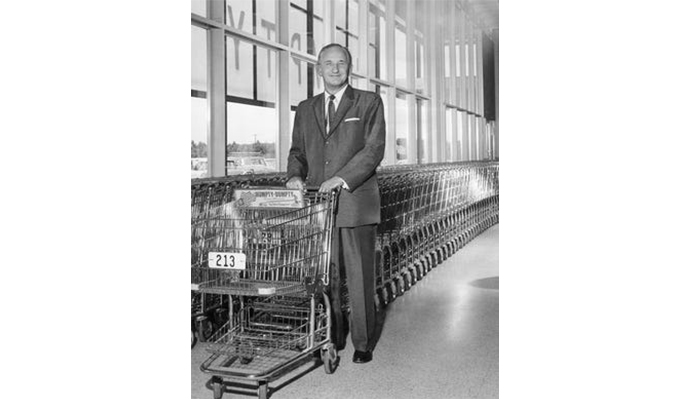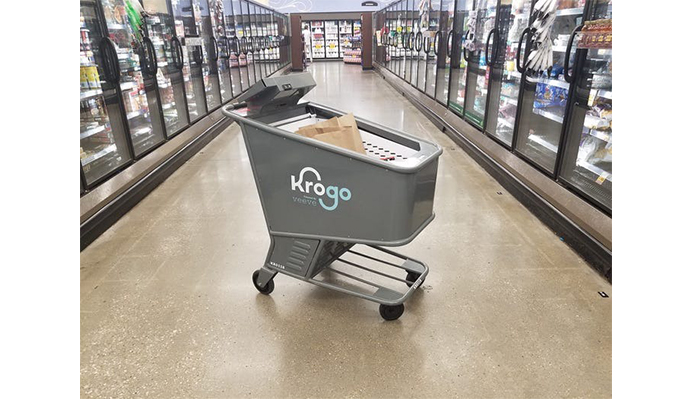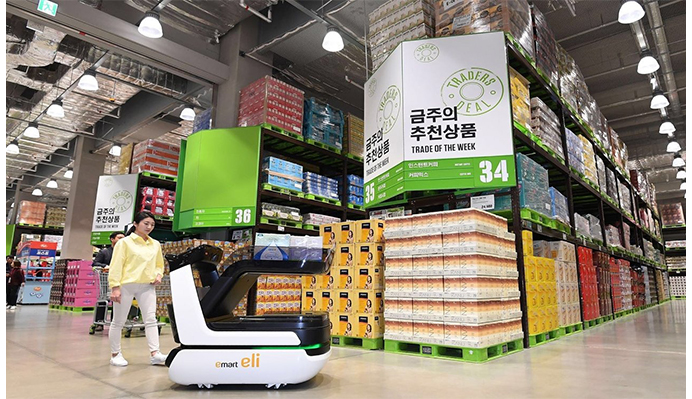In our busy life of retail, we have that silent friend called a shopping cart that assists us in collecting items while our search for things continues. Unbelievable as it sounds, this humble invention is an important milestone with more than a one-century-old history. Today’s shopping cart is a far cry from its simple wooden predecessor and has transformed the entire notion of shopping.
Therefore, in this exploration, we’re going to discuss the history of the shopping cart that took place from the late nineteenth century until the digital era.
When was the Shopping Cart Invented
The First shopping cart was invented by Sylvan Goldman in June 4, 1937, along with his brother Fred. With the introduction of shopping carts shoppers were able to carry big items and a lot of items at once. This made shopping a lot easier and revolutionised the shopping industry.
The Birth of Convenience: Pre-Cart Era
It was quite difficult for the clients as earlier they had to walk along with their goods, sometimes in baskets, sometimes in their hands. Therefore, the lack of a dedicated shopping tool turned grocery shopping into a lengthy and tedious affair.
Shoppers were forced to carry goods from the shelves to the cashier desks since they did not employ any carts. The shopping experience had to be revolutionized and made more efficient by making a major breakthrough
1890s: The Shopping Basket Emerges
However, it was in the 1890s that he developed the notion of a shopping basket. Lighten their shopping journey with wire or wicker baskets available for use in a store. Despite its basic approach to transporting goods, this invention fell short of producing a sufficient answer to the matter. The maneuverability was low while the storage capacity was limited, making an upgrade necessary in the shopping aid world. During this period, a great deal established groundwork for greater sophistication in the shopping cart innovation yet to be encountered.
1930s: The Folding Shopping Cart
The folding shopping carts that were introduced at the beginning of the 1930s considerably revolutionized the design of shopping carts. They were created as small and lightweight to make their movements very easy. When idle, they could be folded compactly for easy storage.
However, this type of folding cart was not perfect at that time. These were small in size and only allowed for a few kilograms of foodstuff. Besides, these shopping carts were not as powerful in terms of storage space compared to today’s shopping carts, which resulted in limited operation. The folding trolleys of these days are meant to cater to daily purposes, including carrying little pieces of goods and going on errands, not the large shopping journeys done nowadays.
The Pioneer of Modern Shopping Carts: Sylvan Goldman
In the 1930s, Sylvan Goldman, who owned a grocery store in Oklahoma, noticed that the traditional shopping devices were unable to satisfy the needs of the customers and retailers. It was Goldman’s insights and innovative spirit that led him to invent the world’s first true shopping cart, which has revolutionized how we shop today. It had a four-part, folding frame structure made of metal with the market cart hanging down off it.
Goldman’s cart had a lot of storage facilities, which was not the case with older ones, making shopping much easier. At the outset, his sharp-witted idea was met with resistance by the customers, but soon he gained acceptability that birthed the modern shopping cart, which is now a fixture in almost every grocery store or supermarket, thus showcasing what an imaginative mind can do in influencing
1937: The Birth of the First Shopping Cart
Together with his brother Fred, Sylvan Goldman invented and implemented the world’s first-ever trolley or shopping cart in 1937. They invented this four-wheeled, foldable carriage, which incorporated a basket-like structure attached to the metal framework along with tiny wheels.

The introduction of this cart was a great relief for shoppers. They were able to carry bulkier items, and the process of shopping became easier for them. This gave birth to a retail revolution that has affected global consumers for centuries.
Initial Resistance: The “Whisker Biscuit”
Initially, the shopping cart faced resistance owing to its practicality and convenience. The gadget was a new invention that people hesitated to accept. They used witty names for it, such as the “whisker biscuit” and “basket on wheels.”
The playful nicknames mirrored one’s doubt with that novelty shopper guide. As the initial resistance towards the product’s usage, Sylvan Goldman tried a good trick. He recruited some people pretending to be “shoppers” who pushed trolleys through the store in order to create a feeling that he was accepted by society. This innovative marketing approach assisted clients to get over their fears and opened the door for the shopping cart, which is now popular in the world of business.
1940s: Widespread Adoption of the Shopping Cart
However, it became apparent that these shopping carts were convenient and useful during the 1940s, thus creating a market demand for the carts among retailers and customers as well. It was this age that would see the introduction of some crucial developments that made the shopping experience more fun. The retailers recognized that large storage capacity was desired, and the manufacturers provided them with shopping carts with expanded baskets.
Moreover, a child seat also became part of the design, which further enhanced shopping trip friendliness for parents, who could now easily move around with their children through shopping centers. These additional features, together with its original function of facilitating movement in grocery stores and supermarkets in the United States, made it an essential tool. Shopping carts ceased to be an innovation and became a part of modern stores where the convenience of shoppers takes the first priority.
1950s: The Modern Shopping Cart Design
The 1950s marked a major revolution in the development of shopping cart features that we are familiar with today. In this period of time, manufacturers reacted to the need of buyers to improve toughness, bigger storage space, and better movement. Thus, shopping carts were built using strong metal frames, making them durable and hardy, vital attributes needed for daily usage purposes.

In response, extra large storage compartments were added where customers could comfortably carry different types of commodities that they wanted to buy. Smooth-rolling wheels were also introduced, leading to improved mobility within stores, therefore making shopping easier and quicker. However, the contemporary shopping cart still largely adopts the same framework that was instituted during the 1950s; hence, this ingenious invention is a successful and functional one.
The Evolution Continues: New Features and Adaptations
This led to continual development and adaptation of shopping carts since they became more and more prominent in the whole shopping process. Shopping carts have undergone several transformations in response to shifting customer and retail business expectations. This was to enhance convenience, durability, and the overall shopping experience, demonstrating the retail industry’s efforts to remain relevant to its consumers.
The 1970s: Plastic Grocery Carts
In the 1970s, there were serious modifications in the way shopping carts were constructed, which replaced old-fashioned metal carts with plastic grocery carts. The plastic carts had numerous benefits that addressed the major issues. Firstly, they were light, thus easy to move around by the buyers and shop attendants. Additionally, plastic carts were easy to clean and maintain, which was vital in consideration of hygienic conditions at that time.
They also did not get rusted as easily as the previous ones, which further increased their life span and lowered the cost of maintenance. Moreover, this helped to keep their appearance clean and new. Plastic shopping carts were also cheap and affordable to most retailers. The move to plastic as the new industry standard can be considered a very reasonable and intelligent response to the increasing needs of both retailers and buyers, which has resulted in a continuous evolution of the shopping cart to better meet the requirements of the users.
1980s: The Advent of Shopping Cart Wheels with Swivels
It is notable that in the 1980s, there was a remarkable innovation that led to the adoption of swivel wheels for the world of shopping carts. Prior to this development, traditional carts were only wheeled, and this made the traditional carts difficult to maneuver through the busy aisles of the stores. The swivel wheels enabled better navigation in narrow areas and within the store arrangement.
This improvement greatly enriched the customers’ shopping experience as it minimized the irritation caused by walking down congested aisles. The introduction of swivel wheels made the shopping cart more convenient to use but increased sales for retailers and efficiency of store layouts. Adaptations of this device in the 1980s showed the continuation of efforts to create the perfect tool for changing the retail world.
1990s: Child Seats and Cup Holders
Supermarkets also noticed the need to serve family shoppers and made significant changes in the design of shopping carts in the 1990s. The adaptations were made specifically for family shopping. Significantly, shopping carts with child seats were among some of the additions. In a nutshell, this made it possible for parents to safely and easily move around with their small kids as they went about buying. More convenience in shopping was provided to parents since through cup holders, drinks and snacks could be easily accessible when required.

These innovations not only made shopping enjoyable among families but also encouraged parents with young children to frequently visit the supermarket, showing that grocery stores are accommodating places for the family. There was a lot of evolution involved in the design of shopping carts in the 1990s as it aimed at enhancing user experience and meeting the needs of different users.
The Digital Age and Beyond: Smart Carts and Beyond
The start of the century marked a chapter, in the evolution of shopping carts as technology advanced and opened up new possibilities. Retailers and tech companies saw the potential, for using solutions to improve the shopping experience. As a result smart shopping carts emerged as a game changer integrating technology to make shopping more convenient, efficient and engaging.

This has resulted in the creation of shopping carts, which have the potential to completely transform the shopping experience more. These advanced carts, incorporating technology strive to enhance convenience, efficiency and interactivity during the shopping process.
2000s: Self-Checkout Kiosks and Scannable Carts
In the 2000s, the retail underwent a rapid transformation by introducing self-checkout kiosks and scan-able carts. The innovations were based on bar-code scanning and enabled customers to scan and pay while shopping. Such made the checkout shorter, thereby eliminating long queues at traditional registers.
Customers could even scan their own items, checkout, and pay with nothing more than their phones. The adoption of self-checkout technology enhanced efficiency in shopping processes as well as providing convenience for those tech-savvy shoppers. In the 2000s, technology transformed the traditional shopping at the store into a fast and autonomic way to pay, thus altering their experience.
2020s: The Rise of Autonomous Shopping Carts
Autonomous shopping carts are the most recent manifestation of the evolution of shopping carts in the 2020s. The automated, self-driving shopping carts that can follow a customer, scan items, and even help with bagging groceries are the best examples of such products. The innovation could further enhance shoppers’ convenience and save them more time. Autonomous shopping carts make shopping for customers easier by acting almost like personal shopping assistants, following them around as they browse the store, keeping track of items, and streamlining the checkout process.

Using the most modern technology of computer vision and artificial intelligence, these self-guiding carts are aimed at radically changing a traditional in-store shopping process and providing easier access to the products to people with some physical limitations. It is a decade that has prepared a new generation of shopping cart innovation, which is still based on the use of technology in order to provide modern customer requirements.
Conclusion
The history of the shopping cart is living proof that innovation and human creativity can accomplish anything. The development of shopping carts in the market has changed tremendously, from the “Whisker Biscuit” to today’s independent smart carts.
The shopping cart is likely to keep changing with time as technology keeps changing, and so do consumer preferences. However, the shape and use of the shopping cart could continue to alter, but the main purpose, which is to make shopping easier, will remain the same.
Hence, when you push the shopping trolley along the aisle of your favorite store, spare a thought for the amazing history of this quiet ally that spans a full century. Its journey from “Whisker Biscuit” to being one of the most prominent retail players has definitely left its marks on shopping and our engagement with the broader retail industry. The shopping cart has survived from wicker baskets to autonomous smart carts – a symbol of retail convenience.
Acowebs are the developers of Woocommerce Custom Product Addons which is a optimized, lightweight, and fruitful plugin that is simply the best to add extra product options using its custom form builder easily. WooCommerce custom fields also comes with drag and drop form builder, 22+ field types and custom price formula.












 Login
Login
 Cart
Cart







